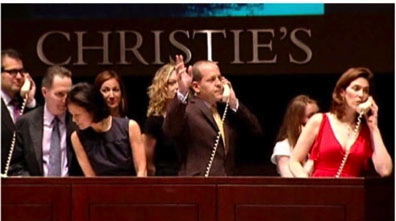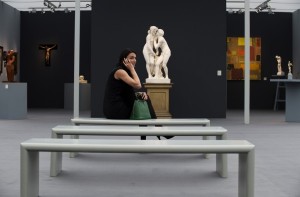![]()
Barry X Ball’s Matthew Barney/BXB Dual-Dual Portrait Ensemble (2012) During this year’s Basel week, few artists made as much impact as Iván Navarro, whose fluorescent light sculptures sparked a crackling buzz in the big fair’s Art Kabinett sector and at its Art Public outdoor sculpture garden.
The Chilean-born talent’s “Impenetrables” project showcased five pieces made of neon ladders and mirrors that appeared to rise from an abyss beneath the convention center’s floor. The works, which continued Navarro’s exploration of the relationship between viewers and their architectural surroundings, were among the few must-see exhibits that cut through the white noise of Miami’s busiest cultural week.
But if you missed that show, don’t panic. You can still catch Navarro’s solo exhibit at the Frost Art Museum, where his sprawling show will remain on view long after the cacophony of Basel week has departed. His exhibit is one of several stellar museum shows, in fact, that will stay on display well into the new year.
“This exhibition offers our visitors the opportunity to fully understand the context of work that may, at first, appear as fragile constructions made of ordinary manmade objects,” says Carol Damian, the Frost’s director and chief curator.
Some might remember Navarro’s work from a group show called “Artificial Light,” organized by North Miami’s Museum of Contemporary Art at its Wynwood satellite space for ABMB’s 2006 edition. Back then, Navarro exhibited a pair of beautiful purple neon chairs so beguiling that a female spectator sat on them and crushed the neon-gas-and-glass creations.
This year, the electrifying talent is the subject of the Frost’s “Ivan Navarro: Fluorescent Light Sculptures,” featuring three floor sculptures, 14 wall sculptures, and three videos that illuminate his multilayered practice over the past ten years.
The exhibit includes Navarro’s The Nowhere Man series, making its debut in a U.S. museum. Inspired by the iconic pictograms created by Otl Aicher for the 1972 Olympics in Munich, its all-white, genderless stick figures appear to be running, jumping, and swimming. (Through January 27 at the Frost Art Museum at FIU, 10975 SW 17th St., Miami; 305-348-2890; thefrost.fiu.edu.)
Perhaps no other museum show drew a larger audience for its Basel opening than the Bass Museum of Art, where “The Endless Renaissance: Six Solo Artists Projects” brought together an impressive cast of talent from the United States, Finland, Germany, Thailand, and the United Kingdom to explore how historical works and concepts transform across time and morph through the eyes of diverse audiences.
“‘The Endless Renaissance’ links art from the past and the present, each artist in his or her own way, directly or indirectly,” says Silvia Karman Cubiñá, the Bass’s executive director and chief curator.
Take Barry X Ball’s sculptures, which twist classically inspired busts by using bleeding-edge computer technology to carve unusual materials. To create his whiplash-inducing Matthew Barney/BXB Dual-Dual Portrait Ensemble, Ball started with Mexican onyx, stainless steel, and various other materials. Then he employed an arsenal of equipment, including 3-D digital scanning, virtual modeling, and computer-controlled milling, to create a hyper-detailed face. Ball finishes the pieces by hand-carving and polishing the uncanny visages.
Another virtuoso work is his Sleeping Hermaphrodite, which features an eerily smooth figure lying nude on a mattress while tangled in a bed sheet. Ball’s brilliant handling of flesh and drapery boggles the mind and brings to mind the timeless symmetry and perfection of classical Greek sculpture.
Another notable artist at the Bass is Germany’s Hans-Peter Feldmann, who collects, orders, and re-presents amateur print photographic reproductions, toys, and trivial works of art. His painting of what appears to be a 19th-century aristocrat wearing a red clown nose is full of humor while smacking the starch out of tired notions of traditional portraiture.
Thailand’s Araya Rasdjarmrearnsook, meanwhile, considers art through an outsider’s eye with her Two Planets series, in which she presents classic European paintings to villagers in remote Thai towns and then films them discussing the works. Her enchanting digital print Two Planets: Manet’s Luncheon on the Grass and the Thai Villagers, 2012, upends traditional Western notions of viewing and interpreting artwork and helps viewers see these famous paintings anew. (Through March 17 at the Bass Museum of Art, 2100 Collins Ave., Miami Beach; 305-673-7530; bassmuseum.org.)
At the Museum of Contemporary Art in North Miami, Bill Viola’s powerful video installations deliver a poignant commentary of how art can uplift the spirit. “Bill Viola: Liber Insularum” is the video pioneer’s first American museum survey since 2003.
“Many of these are among his most powerful works to date,” says Bonnie Clearwater, the museum’s chief curator and director. “These are emotional and spiritual works that speak to the human condition.”
Viola’s sensory-engulfing opuses typically delve into the concepts of birth and death, with a nod to both Eastern and Western art, as well as mystical, spiritual traditions.
MOCA’s exhibit was inspired by 15th-century Florentine cleric Cristoforo Buondelmonti’s tome The Book of the Islands of Archipelago, which records six years he spent wandering the Aegean Sea. Viola departs from that compass point to explore universal notions of being and nothingness, using the tale as an allegory of our lives wandering a transforming global landscape. (Through March 3 at the Museum of Contemporary Art, 770 NE 125th St., North Miami; 305-893-6211; mocanomi.org.)






























![[image]](http://si.wsj.net/public/resources/images/AR-AA426A_Art4_G_20121115225147.jpg) Christie's
Christie's








